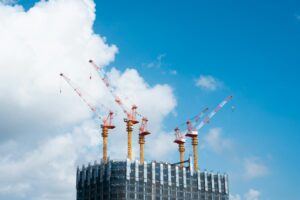The construction industry is under growing pressure to reduce its environmental impact, with developers, regulators, and clients demanding greener practices. While many construction companies want to go green, the realities on-site make it difficult. High fuel consumption, compliance demands, pollution complaints, rising costs, and unreliable power supplies create serious roadblocks.
But with the right technology, specifically Battery Energy Storage Systems (BESS) like Infinity Cube, sustainable construction is not just possible, but practical, profitable, and future-ready.
Challenge #1: High Fuel Consumption
Despite a growing interest in renewables, diesel generators remain the backbone of power supply on most construction sites. However, they’re notoriously inefficient, especially when loads fluctuate.
- Generators often run under-loaded, wasting diesel and creating unnecessary emissions.
- Fuel use can be extreme, particularly on larger or 24/7 sites.
- Idling during breaks or standby periods still consumes fuel with no productive output.
This overreliance on diesel is not only expensive but also makes it difficult to meet sustainability targets.
Challenge #2: Emissions Compliance Pressure
Construction firms in Singapore and across the region now face tightening emissions regulations:
- Carbon Tax: Singapore’s tax on greenhouse gas emissions is increasing from S$5/tCO₂e to as much as S$80/tCO₂e by 2030.
- Mandatory Reporting: Listed companies and large emitters must track and report Scope 1 and Scope 2 emissions.
- Client & Tender Requirements: Major developers are factoring in carbon performance when awarding contracts.
Failing to address emissions is no longer just bad for the planet, it’s a compliance risk that can result in lost tenders or regulatory penalties.
Challenge #3: Noise & Air Pollution Complaints
In urban environments, noise and pollution from generators have become a major issue:
- 24/7 generator use creates constant noise pollution, disrupting nearby residents.
- Exhaust fumes produced by diesel generators impacts air quality, triggering complaints from communities and scrutiny from authorities.
- Some cities are now enforcing site noise limits and low-emission construction zones.
These challenges threaten project timelines and reputations, particularly for contractors operating in dense, high-profile developments.
Challenge #4: Rising Operating Costs
Construction margins are shrinking as operating costs continue to climb:
- Volatile diesel prices make fuel budgets unpredictable and often higher than forecasted.
- Labour and maintenance costs for managing power systems increase as equipment ages and sites grow.
- Generator servicing is frequent and costly, especially when running non-stop.
Over time, traditional diesel-only setups become financially unsustainable, particularly when scaled across multiple sites.
Challenge #5: Power Reliability on Remote Sites
On off-grid, remote, or offshore projects, power reliability is mission-critical and hard to guarantee:
- Grid access is often unavailable or unstable.
- Generators frequently fail due to overuse, improper sizing, or extreme conditions.
- Fuel deliveries may be delayed, causing productivity losses.
These factors lead to frequent downtime, halted work, and inflated costs, not to mention safety concerns when critical systems go offline.
How Infinity Cube’s BESS Solves These Green Construction Challenges

Infinity Cube is a smart, pre-approved hybrid power solution designed specifically for the demands of construction. It tackles each challenge with precision:
Lower Fuel Consumption
- BESS handles low and variable loads, allowing generators to shut off when not needed.
- Fuel savings of 30–60% are common, reducing both cost and emissions.
Emissions Compliance & Reporting
- Built-in monitoring tracks fuel use and emissions in real time.
- Supports carbon reporting for Scope 1 & 2, aiding compliance with NEA and SGX regulations.
- Eligible for green energy grants like the Energy Efficiency Fund (E2F).
Reduced Noise & Air Pollution
- Quiet battery operation during light-load periods cuts generator noise completely.
- Lower generator runtime means fewer emissions and cleaner air for nearby communities.
Lower Operating Costs
- Less generator use means fewer services, lower maintenance costs, and extended equipment life.
- Automated control and cloud monitoring reduce manual oversight and staffing costs.
Reliable Power Anywhere
- BESS delivers stable, uninterrupted power, even during generator maintenance or outages.
- Remote monitoring and predictive maintenance tools ensure maximum uptime on the most challenging sites.
With Infinity Cube, construction companies can transition to cleaner energy without sacrificing performance or profit.
Conclusion: Making Green Construction Practical and Profitable
The shift to greener construction isn’t just an environmental obligation, it’s an operational necessity. While traditional power setups struggle to keep pace with modern demands, Infinity Cube’s hybrid BESS solution offers a reliable, cost-effective, and regulation-ready alternative.
Whether you’re dealing with urban restrictions, remote projects, or rising costs, Infinity Cube enables you to build more sustainably, without compromise.
Take the first step toward greener, more efficient construction projects. Talk to Infinity Cube today.


